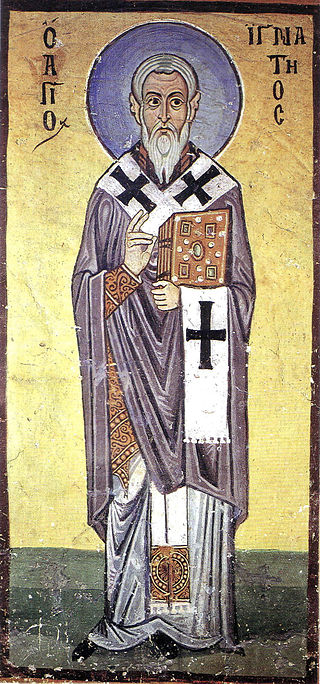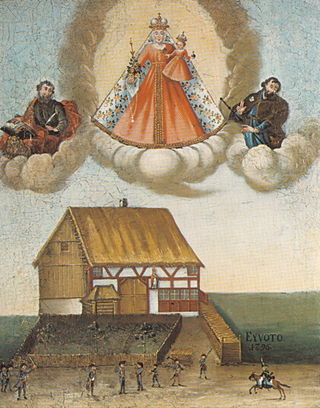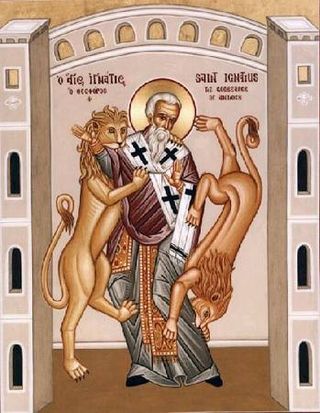
Martyrium Ignatii is a work that claims to be an eye witness of the events leading up to his death and the martyrdom of Saint Ignatius. [1] [2]

Martyrium Ignatii is a work that claims to be an eye witness of the events leading up to his death and the martyrdom of Saint Ignatius. [1] [2]
Its most reliable manuscript is the 10th-century Codex Colbertinus (Paris), in which the Martyrium closes the collection. The Martyrium presents the confrontation of the bishop Ignatius with Trajan at Antioch, a familiar trope of Acts of the martyrs, and many details of the long, partly overland voyage to Rome. [3] [4] [5] The writer has been said to be a deacon in Tarsus named Philo and Rheus Agathopus. However, even scholars who accept the book as authentic believe that it has been heavily edited by later authors. [6] [7]
The book tells the story of Ignatius' death and the events leading up to his death, the book also implies that Ignatius was one of the children Christ held in Matt. 18:2. [8] [6]

The Acts of the Apostles is the fifth book of the New Testament; it tells of the founding of the Christian Church and the spread of its message to the Roman Empire.
The Book of Habakkuk is the eighth book of the 12 minor prophets of the Bible. It is attributed to the prophet Habakkuk, and was probably composed in the late 7th century BC. The original text was written in the Hebrew language.

Ignatius of Antioch, also known as Ignatius Theophorus, was an early Christian writer and Patriarch of Antioch. While en route to Rome, where he met his martyrdom, Ignatius wrote a series of letters. This correspondence forms a central part of a later collection of works by the Apostolic Fathers. He is considered one of the three most important of these, together with Clement of Rome and Polycarp. His letters also serve as an example of early Christian theology, and address important topics including ecclesiology, the sacraments, and the role of bishops.

Paul also named Saul of Tarsus, commonly known as Paul the Apostle and Saint Paul, was a Christian apostle who spread the teachings of Jesus in the first-century world. For his contributions towards the New Testament, he is generally regarded as one of the most important figures of the Apostolic Age, and he also founded several Christian communities in Asia Minor and Europe from the mid-40s to the mid-50s AD.

Polycarp was a Christian bishop of Smyrna. According to the Martyrdom of Polycarp, he died a martyr, bound and burned at the stake, then stabbed when the fire failed to consume his body. Polycarp is regarded as a saint and Church Father in the Eastern Orthodox Church, Roman Catholic Church, Oriental Orthodox Churches, Lutheranism, and Anglicanism.

2 Peter, also known as the Second Epistle of Peter and abbreviated as 2 Pet., is an epistle of the New Testament written in Koine Greek. It identifies the author as "Simon Peter", a bondservant and apostle of Jesus Christ". The epistle is traditionally attributed to Peter the Apostle, but most scholars consider the epistle pseudepigraphical Scholars estimate the date of authorship anywhere from AD 60 to 150.
The Apostolic Fathers, also known as the Ante-Nicene Fathers, were core Christian theologians among the Church Fathers who lived in the 1st and 2nd centuries AD who are believed to have personally known some of the Twelve Apostles or to have been significantly influenced by them. Their writings, though widely circulated in early Christianity, were not included in the canon of the New Testament. Many of the writings derive from the same time period and geographical location as other works of early Christian literature which came to be part of the New Testament.

Intercession or intercessory prayer is the act of praying to a deity on behalf of others, or asking a saint in heaven to pray on behalf of oneself or for others.

The New Testament apocrypha are a number of writings by early Christians that give accounts of Jesus and his teachings, the nature of God, or the teachings of his apostles and of their lives. Some of these writings were cited as scripture by early Christians, but since the fifth century a widespread consensus has emerged limiting the New Testament to the 27 books of the modern canon. Roman Catholic, Eastern Orthodox, and Protestant churches generally do not view the New Testament apocrypha as part of the Bible.
The Odes of Solomon are a collection of 42 odes attributed to Solomon. There used to be confusion among scholars on the dating of the Odes of Solomon; however, most scholars date it to somewhere between 70-125 AD. The original language of the Odes is thought to have been either Greek or Syriac, and the majority of scholars believe it to have been written by a Jewish Christian, very likely a convert from the Essene community to Christianity, because it contains multiple similarities to writings found in Qumran and to the Gospel of John. Some have argued that the writer had even personally seen John the Baptist
Martyrdom of Polycarp is a manuscript written in the form of a letter that relates the religious martyrdom of Polycarp, Bishop of Smyrna and disciple of John the Apostle in the 2nd century AD. It forms the earliest account of Christian martyrdom outside of the New Testament. The author of Martyrdom of Polycarp is unknown, but it has been attributed to members of the group of early Christian theologians known as the Church Fathers. The letter, sent from the church in Smyrna to another church in Asia Minor at Philomelium, is partly written from the point of view of an eye-witness, recounting the arrest of the elderly Polycarp, the Romans' attempt to execute him by fire, and subsequent miraculous events.

The Epistle of Polycarp to the Philippians is an epistle attributed to Polycarp, an early bishop of Smyrna, and addressed to the early Christian church in Philippi. It is widely believed to be a composite of material written at two different times, in the first half of the second century. The epistle is described by Irenaeus as follows:
Walter C. Kaiser Jr. is an American Evangelical Old Testament scholar, writer, public speaker, and educator. Kaiser is the Colman M. Mockler distinguished Professor of Old Testament and former President of Gordon-Conwell Theological Seminary in South Hamilton, Massachusetts, retired June 30, 2006. He was succeeded by James Emery White.

The Epistle of Ignatius to the Smyrnaeans is an epistle from circa 110 A.D. attributed to Ignatius of Antioch, a second-century bishop of Antioch, addressed to the Early Christians in Smyrna.

Saint Peter, also known as Peter the Apostle, Simon Peter, Simeon, Simon, or Cephas, was one of the Twelve Apostles of Jesus Christ and one of the first leaders of the early Christian Church. He appears repeatedly and prominently in all four New Testament gospels as well as the Acts of the Apostles. Catholic tradition accredits Peter as the first bishop of Rome—or pope—and also as the first bishop of Antioch.

The Epistle of Ignatius to the Romans is an epistle attributed to Ignatius of Antioch, a second-century bishop of Antioch. It was written during his transport from Antioch to his execution in Rome. To the Romans contains Ignatius’ most detailed explanation of his views on martyrdom.

Pseudo-Ignatius was a 4th-century writer who claimed to be Ignatius of Antioch. He is the author of the Ignatian forgeries but he also wrote the Apostolic Constitutions and a Commentary on Job. Harnack also identified Pseudo-Clement with Pseudo-Ignatius. Pseudo-Ignatius has some Arian leanings but is not completely Arian; on the other hand, he in some ways resembles the Apollinarians. However it is not possible to draw clear conclusions on his Christology.
Philo of Cilicia was a second-century deacon who served in Tarsus, he was mentioned by Ignatius of Antioch in his letters to the Smyrneans and Philadelphians. He accompanied Ignatius of Antioch during his journey to Rome.
Rheus Agathopus or Rheius Agathopus was a companion of Ignatius of Antioch and a second century deacon in Syria. He was mentioned along with Philo of Cilicia in two of his epistles, in the epistle to the Smyrneans and Philadelphians. Rheus Agathopus and Philo of Cilicia accompanied Ignatius on his journey to Rome, and the book Martyrium Ignatii has been attributed to him, along with Philo of Cilicia, though even scholars who believe it is authentic often believe that it has been likely largely interpolated. Rheus Agathopus joined Ignatius in Troas.